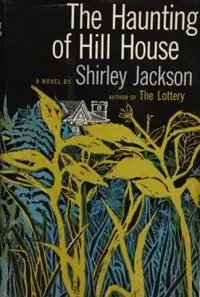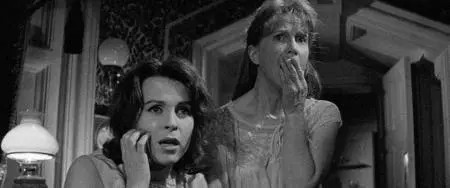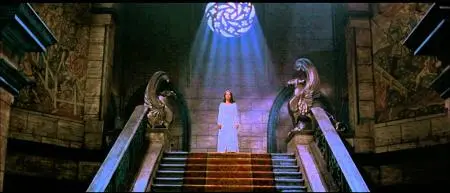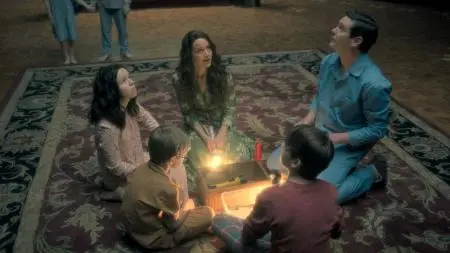In 2019, Shirley Jackson's seminal The Haunting of Hill House will celebrate its 60th birthday. One doesn't need much proof that the book is a classic—it nearly always appears on lists of the greatest horror novels of all time (as evidenced here, here, here, and here), and writers such as Stephen King, Neil Gaiman, Ramsey Campbell, Grady Hendrix, Paul Tremblay, and numerous others continue to lavish the novel with praise.
Filmmakers, too, continually return to Hill House, either through direct adaptation or by paying homage to this archetypical haunted house narrative (see House of the Devil, Sweet, Sweet Lonely Girl, The Awakening, Poltergeist, The Others, and so on). The latest cinematic incarnation comes in the form of Mike Flanagan's original Netflix series, the first adaptation credited to Jackson that bears the full title of the book—although this new Hill House is not exactly a direct adaptation of Jackson's novel. It can be best described as a "remix" of the source material, updating the themes of isolation, psychological torment, and familial tension for the 21st century—proving just how timeless Jackson's work really is.
There have been two other film adaptations of Hill House, the first appearing only a few years after the novel's publication, in 1963, and the next hitting theaters 36 years later, in 1999 (it only took 19 years for Flanagan's reworking of the material to drop on Netflix). This release history raises the question: just how faithful is each adaptation of Hill House, and what does it say about the generation for which the adaptation was intended?
Let us journey through the decades, then, beginning with Jackson's novel and working our way up to Flanagan's TV series.
SPOILERS abound below.
"The Haunting Of Hill House" (1959)
Perhaps second in fame and popularity only to Jackson's short story "The Lottery," Hill House is said to be partly inspired by the Winchester Mystery House in San Jose, California, whereby the widowed Sarah, heiress to the Winchester rifle fortune, continued to build upon her sprawling abode for 40 years in the hopes of confusing and derailing the spirits of those killed by the products of her husband's company. According to the biography Shirley Jackson: A Rather Haunted Life (quoted in a Bustle article by Kristian Wilson):
[The Winchester House's] idiosyncratic design includes gables and turrets bursting out at all angles, corridors that lead nowhere, stairs with uneven risers, trapdoors, and ornamentation featuring spiderwebs and the number thirteen (Winchester believed both had spiritual significance). Hallways are as narrow as two feet; doors open both inward and outward in unexpected places, with some on the upper floors leading directly to a sudden drop. . . . Hill House would incorporate some very similar features, including the disorienting layout...
Naturally, Jackson casts this bewildering, foreboding house as a character all its own, though its motivations—if it can even be said to have any—remain locked away, an impenetrable secret. Rather, Jackson concerns herself with the effects Hill House has on its temporary occupants. As Sophie Missing of The Guardian writes:
The horror inherent in the novel does not lie in Hill House (monstrous though it is) or the events that take place within it, but in the unexplored recesses of its characters'—and its readers'—minds. This is perhaps why it remains the definitive haunted house story.
As such, Hill House is a psychologically complex work of fiction that conjures no easy answers toward the machinations of the human mind. It isn't an easy novel to discuss succinctly, at least where its themes and characters are concerned (for a meatier piece on these topics, see Laura Miller's introduction to the 2006 Penguin Classics edition, reprinted at her website). For anyone unfamiliar with the book's plot, editor and reviewer Paula Guran offers perhaps the most succinct and yet thorough summary available:
The story concerns several people brought together by a professor who wishes to investigate supposed paranormal phenomena in a country house. The dark energies of the house seem to somehow focus on Eleanor Vance—an odd, lonely, somewhat mysterious 32-year-old woman. Despite the terrifying events that begin to occur, Eleanor feels—for the first time in her life—a sense of belonging and happiness in the house. The supernatural occurrences may or may not be directly connected to Eleanor. In fact, neither the characters nor readers are quite sure of what they experience in Hill House—but all are profoundly effected by it.
Despite this summary's conciseness, the other characters should be mentioned here:
 Dr. Montague, the aforementioned professor—he doesn't seem to have a clear grasp on what, exactly, he hopes to accomplish in Hill House; he has no concrete hypothesis, and his methods of study seem to be rooted in a "let's just wait and see if anything happens" approach. One gets the sense he is a bit of a joke among his colleagues, not so much because of his interest in the paranormal, but because he is generally sloppy in his research.
Dr. Montague, the aforementioned professor—he doesn't seem to have a clear grasp on what, exactly, he hopes to accomplish in Hill House; he has no concrete hypothesis, and his methods of study seem to be rooted in a "let's just wait and see if anything happens" approach. One gets the sense he is a bit of a joke among his colleagues, not so much because of his interest in the paranormal, but because he is generally sloppy in his research.
Theodora, no last name, Theo to her friends—a kind of socialite and artist with mild ESP abilities and a tendency toward cutting remarks; though the novel never spells it out entirely, she is likely bisexual, with a particular affection to the "odd, lonely, somewhat mysterious" Eleanor.
Luke Sanderson, future inheritor of Hill House—by all accounts a spoiled rich boy who plays the part of a rake, stealing cash and valuables from his relatives, cheating at card games, getting into trouble, etc. His presence at Hill House during Dr. Montague's experiment is a mandate from Luke's aunt, ostensibly to keep watch over the family property, but in truth simply an opportunity to have him out of her hair for a lengthy period of time.
Eleanor's increasing affection for the home eventually comes to be at odds with the other house guests (Theo especially). For the past eleven years, Eleanor single-handedly cared for her invalid mother, and this, combined with clear social awkwardness and a longstanding subservience to her mother's dicta, casts her as an outsider, someone who hasn't really lived her life. Hill House is her escape from the imprisonment of her caretaker role, of her obedience both of her mother and her sister, from whom Eleanor actually steals a car in order to drive to her summer destination, her first real act of defiance.
And yet, terror soon entwines itself with Eleanor's freedom, at first born from the house itself—or so we think; Eleanor may be controlling the supernatural elements experienced by herself, Theodora, Luke, and Dr. Montague via psychokinesis. But soon terror shifts from the house to her companions, and Eleanor begins to believe the others are her enemies, out to thwart her most primal desires, to imprison her yet again. She relates most closely to a child she observed at the beginning of the novel, who refuses to drink anything unless it is served to her in her "cup of stars." Eleanor wants her own cup of stars, to have things exactly as she wants them, and Hill House embodies this sentiment.
Despite this confidence, the group unwittingly (or perhaps with full awareness) nails Eleanor's true fears on the head, during one of their end-of-the-day parlor conversations:
'I think we are only afraid of ourselves,' the doctor said slowly.
'No,' Luke said. 'Of seeing ourselves clearly and without disguise.'
'Of knowing what we really want,' Theodora said.
Eleanor, naturally, takes nothing from these insights on her mind, however pointed the group intended them to be. She goes on seeing this "not sane" mansion as her true home, her refuge, and when the others attempt to force her out, having witnessed Eleanor's dwindling sanity first-hand, she decides the only way for her to remain in her home is to die on its grounds; thus, she plows her purloined car into the great tree near Hill House's gates. As stated previously, Jackson leaves her readers hanging as to whether or not Eleanor's efforts were fruitful—she may or may not have joined the other spirits roaming the property, if there were ever spirits there to begin with. She ends her novel by suggesting, however, that if Eleanor is there, her isolation persists:
Hill House itself, not sane, stood against its hills, holding darkness within; it had stood so for eighty years and might stand for eighty more. Within, its walls continued upright, bricks met neatly, floors were firm, and doors were sensibly shut. Silence lay steadily against the wood and stone of Hill House, and whatever walked there, walked alone. (emphasis mine)
"The Haunting" (1963)
Because of the novel's complexity, it is tricky to fully encompass Jackson's in-depth psychological examinations on the screen. This first adaptation, written by Nelson Gidding and directed by Robert Wise, comes quite close, especially given the standards of the day—it wasn't possible to overtly establish Theo as queer, for instance, though scenes were shot that concretely established this.
The filmmakers make other big changes to the narrative. Eleanor's last name becomes Lance, rather than Vance, and Dr. Montague becomes Dr. John Markway. Furthermore, the film depicts Eleanor and John as having romantic feelings toward each other (in the novel, their relationship is, at best, father-daughter), a complication ultimately, given the ethical considerations of a doctor and a research subject becoming involved during an investigation, not to mention the fact John has a wife. Called Grace here (in the novel, she's only ever referred to as Mrs. Montague by the others and generally "my dear" by the doctor), this character shows up in the third act in the hopes of convincing her husband to abandon "this nonsense" and come home. When he refuses, Grace decides to stay so that she might prove John wrong: if she experiences no supernatural phenomena, that will be proof the supernatural doesn't actually exist.
But it is the house that proves Grace wrong, as it attempts to swallow her up, to claim her as a victim to satisfy its need for blood and tragedy. Eleanor, having already fallen in love with the house and firm in her belief she belongs there, sacrifices herself in order to set Grace free; Hill House really wants her, after all, so why not give it what it wants. This gambit pays off, Grace reappears and reunites with her husband, and Hill House absorbs Eleanor's spirit, leaving our protagonist to utter, via voice over, the novel's last few lines, but with a twist:
Hill House has stood for 90 years and might stand for 90 more. Within, walls continue upright, bricks meet, floors are firm, and doors are sensibly shut. Silence lies steadily against the wood and stone of Hill House. And we who walk here...walk alone. (emphasis mine)
These changes outlined above represent a significant departure from Jackson's work, the least of which being the removal of the question mark hovering over the denouement. The film states firmly there were ghosts occupying Hill House, and with Eleanor's final voice over, confirms that she is indeed now one of them.
Furthermore, by changing Eleanor's suicide to an act of self-sacrifice, it takes away from the act being a decidedly selfish one—which is not to say that all suicides are selfish acts, but rather, that Eleanor's decision to take her own life represents, for better or worse, her only other act of self-assertion. It is poetic that Eleanor feels a deep sense of freedom after stealing her sister's car and traveling to Hill House, and that she feels this same sense of freedom as she drives the very same car toward a tree on the Hill House grounds, knowingly speeding toward her death. Much like her defiance at the beginning of the novel, Eleanor's suicide is her own way of insisting on her "cup of stars." Ultimately, this is what she wants, even if this desire might be misguided, an expression of madness rather than clarity. By adding in the self-sacrifice element to Eleanor's death, the film takes away from this ending's tragic impact.
This is not to say, though, that The Haunting is a bad film. The acting on display is top notch—especially with Julie Harris as Eleanor and Claire Bloom as Theo—the sets, cinematography, and special effects are beautiful, and its script, even with its departures from Jackson's narrative, is taut and lean. It stands on its own, but one simply has to consider it as a separate work of art from its literary predecessor.
"The Haunting" (1999)
Pretty much critically panned across the board upon its release, this "reimagining" of Robert Wise's 1963 film is much better than its reputation would have you believe. This is not to say it's a great film, per se, but it's an entertaining one. Roger Ebert, of all people, actually gave the film a positive review, praising its visuals and sound design. He writes:
The production design is by Eugenio Zanetti ("What Dreams May Come," "Restoration") and he has done a masterful job of creating interiors that seem to be alive with menace. One of the great moments in the film comes when Taylor and Zeta-Jones explore their bedrooms, which are so rich with detail that you want to wallow in them. The great hall of the house features a walk-in fireplace not unlike the one in Citizen Kane's Xanadu, and indeed when Zeta-Jones first enters Hill House, she murmurs, "It's like Charles Foster Kane meets the Munsters." The horror story itself is based on things that go thump (and bang, and wheeze) in the night. The cavernous halls and ominous corridors reverberate with great groaning echoing noises, as if the house has gas pains. Doors are hammered on. Ghostly manifestations appear...We enter this space and feel enclosed by it; it's not like a set, but more like a virtual reality.
"Taylor" and "Zeta-Jones" refers to Lilli Taylor, who plays Eleanor (mostly referred to as Nell here), and Catherine Zeta-Jones, who plays Theo. There are brief teases of Theo's attempts to seduce Nell, but the protagonist's fears of seeing herself "clearly and without disguise," of "knowing what [she] really wants," are more or less absent here. Gone too are any romantic feelings toward the good doctor—here called Marrow for no discernible reason and played by Liam Neeson. Owen Wilson plays Luke, or rather, he performs his usual "flirty, dopey guy who says 'Wow' a lot' schtick; he's really only there, ultimately, to up the body count, which he does so marginally and rather graphically for a film so otherwise focused on mood and atmosphere (but this was the 1990s, and as such, there had to be some blood). Eleanor also dies, as she did in the previous film and the novel, but this time around, her death is pure sacrifice, a means of becoming a protector of Hill House's ghost children, all of whom were worked to death by the house's first owner, Hugh Crain (also Eleanor is maybe related to the Crains somehow; it's a rushed plot point that, even after multiple viewings, doesn't get any less confusing).
The film plays with some good ideas, especially the ethical debate of conducting experiments on unwitting volunteers (Dr. Marrow brings the group together under the false pretenses of a sleep study), but none of them ever amount to much. Anyone looking for the psychological subtleties of Jackson's novel or even the 1963 film will find only traces of that here. But what can you expect from director Jan de Bont, the guy who did Speed 2 and Twister? This is a special effects-laden, popcorn blockbuster (or would-be blockbuster, anyway), and while the effects are a bit overdone, the film accomplishes what it sets out to do. As the aforementioned Roger Ebert notes:
The movie often edges so close to being truly scary that you wonder why they didn't try just a little harder to write more dimensional characters and add the edge of almost plausible realism that distinguished Shirley Jackson's original novel. The movie does not, alas, succeed as a horror film. But it succeeds as a film worth watching anyway, and that is no small achievement.
"The Haunting of Hill House" (2018)
Spanning ten hour-long (or thereabouts) episodes, Mike Flanagan's new adaptation of Hill House plays out more like a long film than the first season of a TV series. Thematically speaking, this is the most faithful version of Jackson's novel yet, though the plot and characters are virtually new creations altogether. Eleanor Vance, nee Crain (Victoria Pedretti) remains a haunted, tragic figure, though she is tragic in the Greek sense of the word this time around, a woman whose ghosts and demons alike stem from past trauma. Her apparent suicide at the beginning of the narrative serves as the unfortunate catalyst that brings her fragmented family back together. Luke and Theo (played by Oliver Jackson-Cohen and Kate Siegel, respectively) are recast here as Eleanor's siblings, each carrying over prominent aspects of their literary counterparts: Theo is mostly lesbian, but maybe a touch bisexual, and she possesses strong ESP abilities; Luke is the black sheep of the Crain family, who lies and steals to support his raging heroin addiction. The oldest of the Crain children, Shirley and Steven, are also the most skeptical of anything supernatural having happened to them in their childhood. While the former is, naturally, named for the novel's author, Steven has no counterpart in the Jackson universe, which is fitting since he so adamantly refuses to accept their father's "wild ghost stories," he is, emotionally speaking, even more alienated from the family than Luke.
Flanagan also imbues this new narrative with Jackson's flair for toying with the audience. We're not certain from the onset whether the ghosts of Hill House are real or imagined; the aforementioned patriarch Hugh Crain (played in the flashbacks by Henry Thomas and in the present-day scenes by Timmothy Hutton) might be a good guy and a good father who did the best he could, or he might have done something unspeakable during the family's summer stay at Hill House; Eleanor may have killed herself, or ghosts might've killed her; ditto for Crain matriarch Olivia (Carla Gugino), who may have been plagued by supernatural forces or, like the original Eleanor, her own dwindling sanity (or, perhaps, both). And while, ultimately, Flanagan cements the reality of the supernatural in his adaptation (just like the screen versions that came before), numerous questions are left unanswered, even by the series's climax.
Despite the decidedly happy ending (though Flanagan originally intended something much darker), this long film's overarching message insists that we are never truly free from the traumas endured in childhood, that these experiences—whether paranormal or not—leave a lasting and potentially harmful impression well into adulthood, scrambling up our ability to interact with people in general, but especially those we call kin. It is the same lesson we learn from Jackson's Eleanor, but expanded and re-examined in the context of a large family. This new Hill House—one definitely pertinent to the 21st century—wholly embodies Roger Ebert's lament for the 1999 film adaptation: it tries very hard, and successfully so, at giving us dimensional, imperfect characters who carry us through this fantastic narrative. It is thus terrifying not only for its horror elements (including some truly effective jump scares) but for the psychological implications it presents. Even though it is hardly a faithful adaptation where plot and character are concerned, Flanagan's Hill House is by far the best screen version of Jackson's work from a thematic standpoint.
What are your thoughts on the new Hill House series, as well as the two previous films and Jackson's original novel? Let us know what you think in the comments section below.

About the author
Christopher Shultz writes plays and fiction. His works have appeared at The Inkwell Theatre's Playwrights' Night, and in Pseudopod, Unnerving Magazine, Apex Magazine, freeze frame flash fiction and Grievous Angel, among other places. He has also contributed columns on books and film at LitReactor, The Cinematropolis, and Tor.com. Christopher currently lives in Oklahoma City. More info at christophershultz.com










